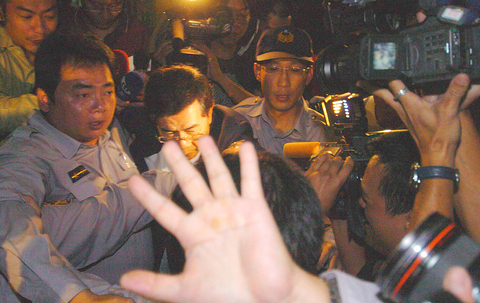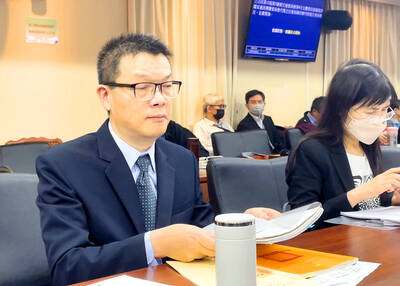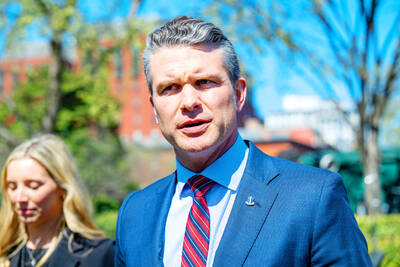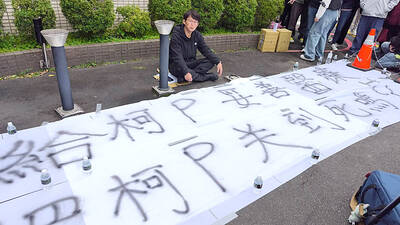Unexpectedly, a scandal that started with a Thai workers riot is now reshaping Taiwan politics.
Not only opposition parties, but also factions inside the Democratic Progressive Party (DPP) and even the local media are attempting to complicate the scandal surrounding the Kaohsiung Rapid Transit Corp (KRTC) in order to take advantage from the situation.
They are expanding the scope of the scandal because they believe that President Chen Shui-bian (

FILE PHOTO: CHANG CHUNG-YI, TAIPEI TIMES
On the other hand, former Kaoshiung city mayor and incumbent Premier Frank Hsieh (謝長廷) has been another target for both opposition and ruling party members. Hsieh, a possible strong contender in the 2008 presidential election, is the planner and builder of the Kaoshiung MRT.
The Kaoshiung City Government began planning to build the MRT in the early 1990s, but the proposal was delayed by former mayor Wu Den-yih (吳敦義), a member of the Chinese Nationalist Party (KMT). Local politicians believed that Wu was unwilling to build the MRT during his term because he was unable to deal with politicians and businessmen who had already cast their covetous eyes on the more than NT$100 billion construction project.
In 1998 Hsieh beat Wu in the mayoral election. Analysts believed that the people of Kaoshiung dumped Wu because the conservative mayor never "contributed to construction in the city." In May 2000, the more aggressive Hsieh announced that the KRTC, which was established in 1999 to bid for the MRT project, beat the Kang Tou Rapid Transit Corp (港都捷運公司) in the race for winning the project bid. The KRTC began construction of the MRT in October 2001.
However, almost four years later, an unexpected riot by Thai workers uncovered the extent of corruption in the KRTC.
On Aug. 21, some 300 of 1,700 Thai workers building the Kaoh-siung MRT rioted over their poor treatment at the hands of Huapan Co, which was appointed by the KRTC to hire and supervise the Thai workers.
After the workers' accusations, it was discovered that the Huapan Co illegally demanded brokerage fees from Thai workers when they applied for work in Taiwan. More seriously, the KRTC was found to be paying each Thai worker NT$29,500 a month, but the workers actually received only about NT$20,000, so more than NT$9,000 of their monthly salary was ending up in somebody else's pockets.
On Aug. 23, Chen Chu (
"The powerful men" have since hogged the headlines in Taiwanese newspapers. Meanwhile, it was alleged that Chen Che-nan and then vice chairman of the KRTC Chen Min-hsien (
"I never went to Thailand and I had nothing to do with the KRTC," Chen Che-nan said more than once.
However, as the scandal continued to expand, on Sept. 5, both Chen Chu and acting Kaohsiung mayor Chen Chi-mai (
On Sept. 6 Kaohsiung judges ordered the detention of Huapan Co's general manager and his wife. A week later, it was found that Chen Min-hsien had illegal brokerage fees flowing into his bank account, he was arrested and released on NT$1.5 million bail.
The scandal further deepened when suspicions were raised about the KRTC's conduct in six public bids for major MRT constructions. Kaohsiung City councilors revealed that although RSEA Engineering Co offered a bid which was NT$2.7 billion lower than that of Hwang Chang Building Co (HCBC), HCBC won the NT$8 billion contract.
To appease public anger and clarify the matter, president Chen asked the new acting Kaohsiung mayor Yeh Chu-lan (葉菊蘭) to form a task force to probe the scandal. After an intensive probe of two weeks, Yeh released the "Kaoh-siung MRT Investigation Report" on Oct. 21.
The report said there was no evidence of "misconduct" by former mayors Hsieh and Wu. But it did not address whether they should be held accountable for their part in adopting a build-operate-transfer (BOT) model that many considered to have been flawed.
The report said, however, that Chen Ming-hsien abused his power to help Tieng Cheng Co win 11 contracts out of 14 public construction bids, with his corrupt practices caused the KRTC to overspend by NT$1.4 billion on the MRT project.
However, the report failed to clear all suspicions. On Oct. 26, when a picture was released by a TVBS talk show showing Chen Che-nan and Chen Min-hsien sitting at a casino table on South Korea's Cheju Island on Nov. 2, 2002, Kaohsiung prosecutors summoned Chen Che-nan for questioning the next day, charged him with corruption and released him on NT$500,000 bail.
Prosecutors proved that Chen Che-nan was entertained by Huapan Co on three foreign trips to Thailand and South Korea.
As the scandal worsened, President Chen on Oct. 30 offered an apology over the KRTC incident.
"I feel sorry and ashamed about Chen Che-nan's integrity problem," the president said.
Chen Chu was summoned for questioning on Oct. 31 by Kaoh-siung prosecutors to learn why the council changed its policy on foreign laborers and whether it was related to alleged intervention by certain prominent figures.
Prosecutors said that the council in May 2001 announced that the county would freeze the introduction of foreign laborers on major infrastructure projects. But in June 2003, the council changed its policy and decided to allow the introduction of foreign workers by the companies in charge of major BOT construction projects.
Prosecutors said that the KRTC in September 2003 had asked the council for permission to use foreign workers, and the council approved KRTC's application at the end of that year.
Kaoshiung prosecutors said they have divided the complicated KRTC scandal into 11 cases because of its gravity. A situation of this magnitude has never occur-red in Taiwanese judicial history, they said.

The High Prosecutors’ Office yesterday withdrew an appeal against the acquittal of a former bank manager 22 years after his death, marking Taiwan’s first instance of prosecutors rendering posthumous justice to a wrongfully convicted defendant. Chu Ching-en (諸慶恩) — formerly a manager at the Taipei branch of BNP Paribas — was in 1999 accused by Weng Mao-chung (翁茂鍾), then-president of Chia Her Industrial Co, of forging a request for a fixed deposit of US$10 million by I-Hwa Industrial Co, a subsidiary of Chia Her, which was used as collateral. Chu was ruled not guilty in the first trial, but was found guilty

DEADLOCK: As the commission is unable to forum a quorum to review license renewal applications, the channel operators are not at fault and can air past their license date The National Communications Commission (NCC) yesterday said that the Public Television Service (PTS) and 36 other television and radio broadcasters could continue airing, despite the commission’s inability to meet a quorum to review their license renewal applications. The licenses of PTS and the other channels are set to expire between this month and June. The National Communications Commission Organization Act (國家通訊傳播委員會組織法) stipulates that the commission must meet the mandated quorum of four to hold a valid meeting. The seven-member commission currently has only three commissioners. “We have informed the channel operators of the progress we have made in reviewing their license renewal applications, and

‘DENIAL DEFENSE’: The US would increase its military presence with uncrewed ships, and submarines, while boosting defense in the Indo-Pacific, a Pete Hegseth memo said The US is reorienting its military strategy to focus primarily on deterring a potential Chinese invasion of Taiwan, a memo signed by US Secretary of Defense Pete Hegseth showed. The memo also called on Taiwan to increase its defense spending. The document, known as the “Interim National Defense Strategic Guidance,” was distributed this month and detailed the national defense plans of US President Donald Trump’s administration, an article in the Washington Post said on Saturday. It outlines how the US can prepare for a potential war with China and defend itself from threats in the “near abroad,” including Greenland and the Panama

Taiwan People’s Party (TPP) Chairman Huang Kuo-chang (黃國昌) yesterday appealed to the authorities to release former Taipei mayor Ko Wen-je (柯文哲) from pretrial detention amid conflicting reports about his health. The TPP at a news conference on Thursday said that Ko should be released to a hospital for treatment, adding that he has blood in his urine and had spells of pain and nausea followed by vomiting over the past three months. Hsieh Yen-yau (謝炎堯), a retired professor of internal medicine and Ko’s former teacher, said that Ko’s symptoms aligned with gallstones, kidney inflammation and potentially dangerous heart conditions. Ko, charged with